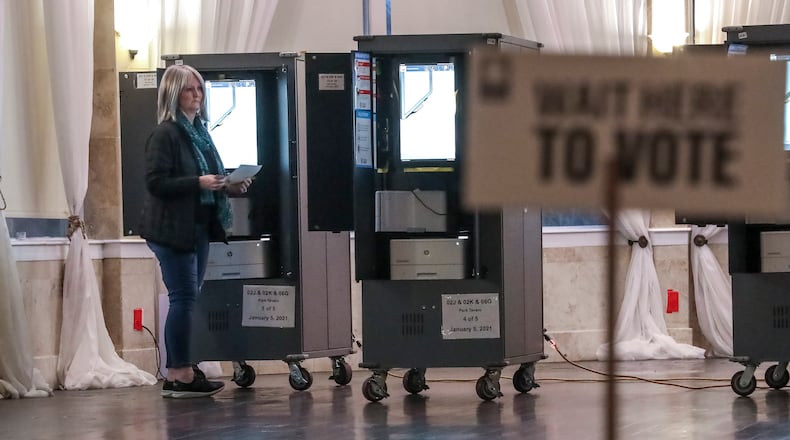Georgia Republicans have begun to challenge the qualifications of thousands of voters who, they argue, may have moved out of the state or have died. These efforts are based on the state’s new SB202 voting law that allows any voter to challenge the eligibility of an unlimited number of their neighbors. The challenges should be worrying for any citizen concerned with election integrity.
Several reasons for concern are already well-known. This effort is occurring outside the regular government-run mechanism for removing people who have died or moved. In addition, it lacks justification because no significant evidence has been found of voting by those who have moved or died. In fact, Georgia’s official process for vetting registration is already one of the country’s strictest, having resulted in the cancellation of over a million outdated registrations from 2017 to 2022 (including deaths and voter-initiated removals).
Credit: contributed
Credit: contributed
In 2017, the state purged 534,000 people, almost 10 percent of all registered voters, in one of, if not the largest, mass cancelations in our country’s history. If anything, the move by private citizens risks exacerbating the problem of the state purging more voters than is justified, with minorities being especially vulnerable to purging.
But Georgia’s own history provides a further, lesser-noted cause for concern: In the post-WWII period, mass challenges to voter qualifications by private citizens constituted an effective mechanism for disenfranchising Black citizens. As is the case today, the challenges followed increased Black political mobilization.
In terms of sheer numbers, Black registration rose rose significantly from around 20,000 in 1940 to almost 200,000, around 18% of the population, in 1946. Over 20,000 Black voters registered in Atlanta in the spring and summer 1946, and by that year around 200,000 Black citizens registered for the statewide gubernatorial race. This growth in Georgia’s Black voter registration contributed to the over 1 million Black registrations across the South prior to the U.S. Supreme Court’s 1954 landmark Brown v. Board of Education ruling.
This rise in registration was facilitated by the Supreme Court’s 1944 invalidating of the “white primary,” whereby by excluding Black voters from its primary elections, the then-dominant Democratic party effectively prevented African Americans from exercising their right to vote in Georgia and across the South.
But equally if not more important than judicial decisions was organized Black political activity, led by groups such as the statewide, Black-led, All-Citizens Registration Committee and groups involving African American WWII veterans. Black veterans also worked within the All-Citizens Registration Committee. And they worked with progressive whites in groups such as the American Veterans Committee, linking voting to bread-and-butter issues such as GI Bill benefits and housing; and they joined with whites to form the Georgia Veterans for Majority Rule in opposition to the county unit system, (an arrangement under which statewide elections were decided by county “unit” votes, similar to today’s Electoral College, rather than by total state population). All of this led to rapid growth in NAACP membership and a threatened march led by A. Philip Randolph that compelled FDR to issue an executive order (8802) banning discrimination in the military.
This Black mobilization constituted a clear threat to Georgia’s Democratic party, led by its gubernatorial candidate, Eugene Talmadge. Democratic supporters responded quickly -- with slowdowns in voting and various forms of intimidation, including Klan cross-burnings, written threats to the Black community and discriminatory employment and business practices.
But the principal Democratic response was mass purging. Shortly before the 1946 gubernatorial primaries, candidate Eugene Talmadge launched a broad campaign to challenge and disqualify Black voters. Talmadge forces mailed out thousands of mimeographed challenge forms to supporters, while also engaging in manipulation of voting machines, and losing or destroying names of purged voters. Blacks were challenged en masse in more than 30 counties, and an estimated 15,000 to 25,000 were purged.
Decisions by individual counties were key to the purging. Often-biased local officials, enabled by the full discretion provided by the law, made ad hoc judgments (through “homemade tests”) of “good character and understanding of citizenship obligations.” The result was a Talmadge victory despite the fact that his opponent won 16,000 more popular votes.
The state General Assembly solidified this method of disenfranchisement in 1949 by passing a new re-registration and purge law. Until its amendment in 1950, the law required re-registration of all voters who had to pass easily manipulable reading and writing tests or answer multiple questions. The law also established a mechanism to facilitate periodic purges of Black voters from the rolls: Voters who did not vote in at least one election in a two-year period were automatically purged, unless they asked for a registration renewal. The law resulted in the purging of 120,000 registered Black voters.
We are not now living in a period of cross burnings and written threats. But the 1940s pattern of Black mobilization followed by mass voter purges bears a concerning resemblance to today’s voter challenges. Today’s challenges follow a significant growth in Georgia’s Black voting population (accounting for half of the state’s 1.9 million increase in voter population between 2000 and 2019) and a 2020 election where high turnout by Black Georgians contributed significantly to a historic Democratic win.
Interfering with the constitutional right to vote was wrong in 1946 and it would be wrong now. Hopefully, history is not repeating itself. But knowing Georgia’s past should make us wary of following an old pattern.
Rick Doner is the Goodrich C. White Professor (Emeritus) of Political Science at Emory University.
About the Author
Keep Reading
The Latest
Featured



